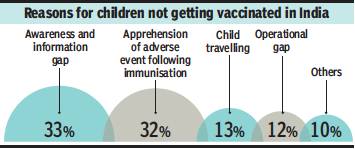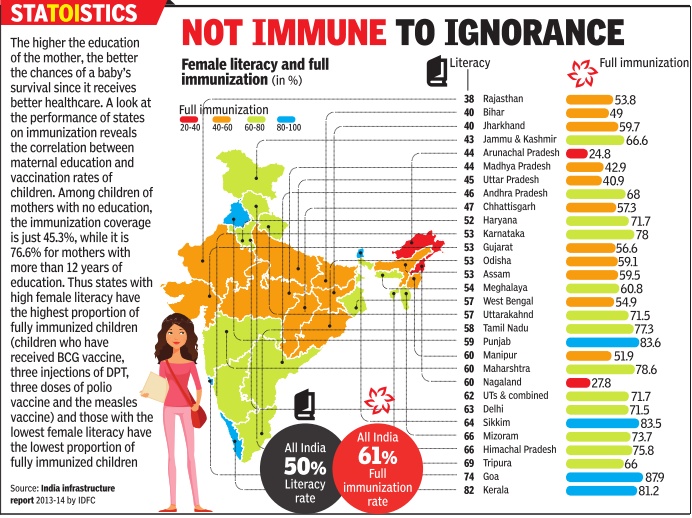Immunisation: India
(→2014-18 growth> and vaccine hesitancy) |
(→2017-18: India behind Bangladesh, Sri Lanka) |
||
| Line 29: | Line 29: | ||
==2017-18: India behind Bangladesh, Sri Lanka== | ==2017-18: India behind Bangladesh, Sri Lanka== | ||
| − | [https://timesofindia.indiatimes.com/india/why-india-lags-sri-lanka-bangladesh-in-immunisation-of-children/articleshow/77805269.cms Rema Nagarajan, Why India lags Sri Lanka, Bangladesh in immunisation of children, August | + | [https://timesofindia.indiatimes.com/india/why-india-lags-sri-lanka-bangladesh-in-immunisation-of-children/articleshow/77805269.cms Rema Nagarajan, Why India lags Sri Lanka, Bangladesh in immunisation of children, August 29, 2020: ''The Times of India''] |
| − | [[File: The percentage on Indian children immunised, presumably as in 2017-18..jpg|The percentage on Indian children immunised, presumably as in 2017-18. <br/> From: [https://timesofindia.indiatimes.com/india/why-india-lags-sri-lanka-bangladesh-in-immunisation-of-children/articleshow/77805269.cms Rema Nagarajan, Why India lags Sri Lanka, Bangladesh in immunisation of children, August | + | [[File: The percentage on Indian children immunised, presumably as in 2017-18..jpg|The percentage on Indian children immunised, presumably as in 2017-18. <br/> From: [https://timesofindia.indiatimes.com/india/why-india-lags-sri-lanka-bangladesh-in-immunisation-of-children/articleshow/77805269.cms Rema Nagarajan, Why India lags Sri Lanka, Bangladesh in immunisation of children, August 29, 2020: ''The Times of India'']|frame|500px]] |
The poor coverage of measles vaccination and later doses of basic vaccines like those for polio, diphtheria, pertussis and tetanus (DPT) are pulling down the proportion of fully immunised children which currently stands at around 60%. This indicates a poor mechanism to track children already registered in the immunisation system despite a Mother and Child Tracking System (MCTS) being in place since 2009. | The poor coverage of measles vaccination and later doses of basic vaccines like those for polio, diphtheria, pertussis and tetanus (DPT) are pulling down the proportion of fully immunised children which currently stands at around 60%. This indicates a poor mechanism to track children already registered in the immunisation system despite a Mother and Child Tracking System (MCTS) being in place since 2009. | ||
| Line 64: | Line 64: | ||
IMMUNISATION: INDIA]] | IMMUNISATION: INDIA]] | ||
[[Category:Name|ALPHABET | [[Category:Name|ALPHABET | ||
| + | IMMUNISATION: INDIA]] | ||
| + | |||
| + | [[Category:Health|IIMMUNISATION: INDIA | ||
| + | IMMUNISATION: INDIA]] | ||
| + | [[Category:India|IIMMUNISATION: INDIA | ||
| + | IMMUNISATION: INDIA]] | ||
| + | [[Category:Name|ALPHABETIMMUNISATION: INDIA | ||
IMMUNISATION: INDIA]] | IMMUNISATION: INDIA]] | ||
Revision as of 23:20, 13 September 2020
This is a collection of articles archived for the excellence of their content. Readers will be able to edit existing articles and post new articles directly |
Contents |
Growth of immunisation
2014-18 growth> and vaccine hesitancy

From: Sushmi Dey, Vaccine refusal among top 10 threats to public health: WHO, January 24, 2019: The Times of India
Refusal or hesitation to get vaccination against deadly diseases despite availability of vaccines is seen as one of the top threats to public health, according to World Health Organisation (WHO). The UN agency recently released a list of what it considers the top 10 threats to global health for 2019, which include air pollution, obesity and antibiotic resistance.
This is the first time that vaccine hesitancy has made it to the UN agency’s list of ten biggest threats to world health. “Vaccination is one of the most cost-effective ways of avoiding disease — it currently prevents 2-3 million deaths a year, and a further 1.5 million could be avoided if global coverage of vaccination improved,” it said.
In India, lack of awareness and information coupled with apprehension of adverse event following immunisation are seen as the major reasons for children not getting vaccinated. The two factors together account for around 65% of the children not getting vaccine coverage, as per government estimates.
Between 2014 and 2018, India’s annual immunisation growth rate has risen to 4% from 1% previously.
2017-18: India behind Bangladesh, Sri Lanka

From: Rema Nagarajan, Why India lags Sri Lanka, Bangladesh in immunisation of children, August 29, 2020: The Times of India
The poor coverage of measles vaccination and later doses of basic vaccines like those for polio, diphtheria, pertussis and tetanus (DPT) are pulling down the proportion of fully immunised children which currently stands at around 60%. This indicates a poor mechanism to track children already registered in the immunisation system despite a Mother and Child Tracking System (MCTS) being in place since 2009.
A recently released NSO report on health for 2017-18 shows that from over 94% coverage for the BCG vaccine given at birth, coverage fell to just 67% for the measles vaccine, given between 9-12 months, the poorest coverage among all basic vaccines needed for a child to be counted as being fully immunised. Similarly, from 94% coverage of the oral polio vaccine’s (OPV) birth dose, the coverage went down with every subsequent dose to reach 80.6% by the third dose. The DPT vaccine coverage went from 91% coverage for the first shot given at six weeks to 78% by the third shot at 14 weeks. This meant that India’s proportion of fully immunised children remained at around 60% in 2017-18, not much different from the National Family Health survey of 2015-16, which found it to be around 62%.
While this was a huge improvement from just 44% in 2005-06, the budget allocated for immunisation has also jumped from Rs 473 crore in 2005-06 to approximately Rs 2,000 crore allocated for the Universal Immunisation Programme (UIP) excluding shared costs such as staff salary, establishments etc. India’s immunisation coverage has remained low relative to its neighbours. In Sri Lanka 99% of children are fully immunised. In Bangladesh, the coverage for DPT-3 was 98% and for measles was 93% in 2018, according to the World Health Report 2020. In Nepal, the coverage for the third shot of DPT was 91% and that for measles was 69%. A child is considered to be fully immunised if she has received BCG, three doses of OPV, three shots of DPT vaccine and the measles vaccine. All these, if delivered on schedule, are within the child’s first year, with measles being the last.
There are booster shots and vaccines for other diseases, but they do not count for considering a child fully immunised. The central government’s Mission Indradhanush launched in December 2014 set the goal of ensuring full immunisation for children up to two years of age and pregnant women. The govt identified 201 high focus districts across 28 states that had the highest number of partially immunised and not immunised children.
Diphtheria immunisation: India lags globally
- Globally in 2019, half of children unvaccinated for DPT3 lived in just six countries: Brazil, Democratic Republic of the Congo, Ethiopia, India, Nigeria, and Pakistan - Despite achieving relatively high rates of immunisation coverage, India hosts 2.1 million of the under-vaccinated even with 91% coverage of a cohort of approximately 21 million surviving infants
How Covid-19 put immunisation on hold
Early in the course of the pandemic in India, several states had curtailed outreach services for immunisation and maternal health services such as ante-natal check-ups citing the need to take precautions against Covid-19 infection as TOI reported on April 2.
An estimated 26 million children are born in India each year, which is more than 71,000 babies each day. Every day of immunisation services remaining suspended thus could mean thousands missing crucial vaccines. Public health experts warned against suspension of these crucial services saying it could lead to an increase in maternal mortality and further lower the already low immunisation levels in most states.
In Uttar Pradesh, Bihar, Rajasthan, Kerala and Karnataka, governments suspended outreach programmes like organising of vaccination days or door-step services. Though most states continued to offer vaccination in primary health centres, district hospitals, medical colleges etc., most health facilities, being too far away, were difficult for people to access, especially with the transport lockdown. Even in states where vaccination work was not formally suspended, additional Covid work imposed on health care workers threw it out of gear.
The impact is evident in data from the union health ministry’s Health Management Information System. For the period from April to June this year, it shows a huge fall in the number of children who got the various vaccines that are part of the Universal Immunisation Programme. For each vaccine, the number of children who got it this April-June is lower by anywhere between 12 and 22 lakh than in the same period last year. The number of fully immunised children aged 9 to 11 months is about 16 lakh less.
While all non-Covid health services have suffered during the pandemic, the setback to immunisation services could mean an outbreak of deadly diseases like measles, not just now, but well into the future. While the government might manage to vaccinate many of the children who missed a shot in this period through mop-up rounds, in many cases the window to give a particular vaccine might have closed, as many vaccines cannot be given beyond a particular period of time. According to Unicef, during the outbreak of Ebola in Congo, while 2,000 died of the epidemic outbreak, double that number died of measles as immunisation services were affected. There is apprehension in the public health community in India now that the disruption of immunisation services during Covid might similarly end up leading to greater maternal and infant mortality.
Immunisation and literacy

See graphic
Immunisation and literacy. Chart